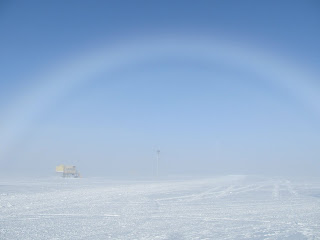 The Director of the National Science Foundation made a visit to Summit Camp today, reportedly the first director to do so. I believe I did an adequate job on showing him and the other NSF guests around the MSF while explaining what ICECAPS is about.
The Director of the National Science Foundation made a visit to Summit Camp today, reportedly the first director to do so. I believe I did an adequate job on showing him and the other NSF guests around the MSF while explaining what ICECAPS is about.They are flying out on a twin otter plane early tomorrow morning. Fortunately the new director, Dr. Suresh, spoke about changes to come in the next month and gave a wonderful overview of the role of the National Science Foundation.
With very little overhead the NSF funds programs in education, social sciences, natural sciences, and pretty much any other science you can think of. It really got me thinking about the value that science has and the deep seeded respect for it I have grown to take for granted.
One question posed to defenders of science is: "What exactly is its value." The value I believe this question refers to is a superficial one, with short term vision and a monetary tone. The true value cannot be known beforehand. An idea could be completely wrong or it could break the surface of our understanding, freeing a rush of new possibilities. Somewhere in between these two extremes the tedious part happens, facts are verified and details are nailed down. This is the value of the NSF, a resource across many disciplines creating opportunities for discovery and innovation.
For me it is easy to see that corporations are not the answer to economic problems. They often have short term gains in sight and despite their judicial rights they suffer little consequences for their wrongs. What must be addressed are issues as a whole, which may include aspects such as social, environmental, economic, energy supply, and health. Without entities like the NSF these pieces are easily compartmentalized and a synergistic solution could be easily disregarded.
As we float down the river of progress we can't hope to always rely on the same notions or we'll find ourselves resourcing the same ideas over and over until they are dry. To carry us further, we need the tools to break though to new well springs of truth. In my opinion scientific thought is the best tool for discovery and innovative solutions.




































